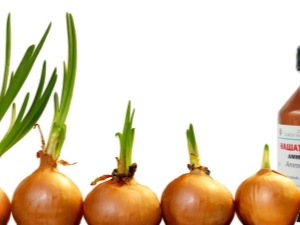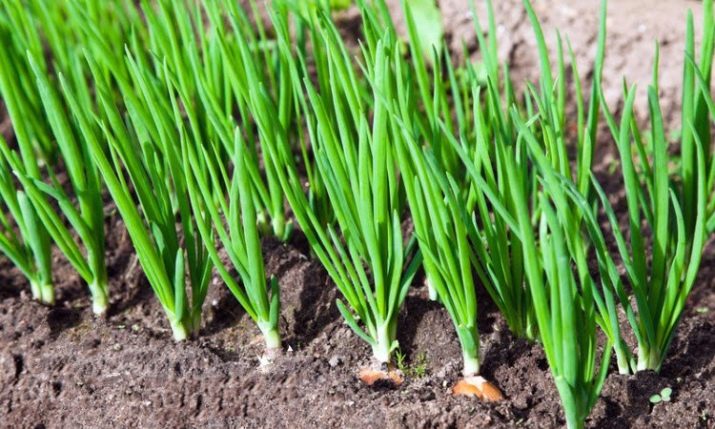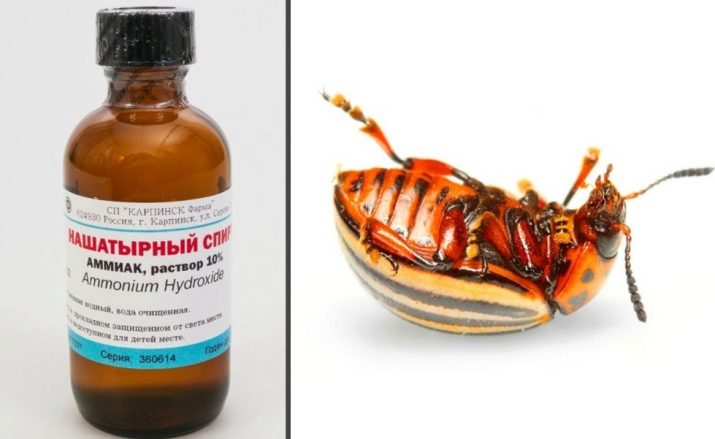How to apply ammonia for onions and garlic?

Many gardeners prefer to solve the issue of fertilizing with improvised means, without going to specialized stores.For example, the use of ammonia is gaining popularity recently. It is believed that feeding onions and garlic with this inexpensive drug leads to impressive results.
Properties
Ammonia can be obtained by combining water and ammonia. By itself, ammonia has no color, but has a rather unpleasant aroma. Ammonia is sold in the form of a 10% solution, which is sold in any pharmacy and sold without a prescription. The presence of 82% nitrogen in the composition explains the benefit of this fertilizer in the garden - it almost immediately promotes the active growth of plants, helping to form chlorophyll in the green parts.
Cultures usually consume it directly from the soil, but if it is poor, then you have to bring it in yourself. In addition, ammonia has a beneficial effect on the onion and garlic in that it repels traditional pests with its smell: aphids, onions and carrots, weevils and wireworms. Thus, liquid ammonia has a dual use: it helps to feed the culture and protect it from insects.
It is important to note that the use of ammonia as a fertilizer eliminates nitrates from vegetables. In garlic and onion heads, nitrogen does not accumulate, but is quickly absorbed - it makes the fruit large and significantly improves the characteristics of feathers. Ammonia is quite cheap, moreover, it is not so much consumed, so this feeding will not hit the gardener's wallet a lot. It is important to add that overfeeding cultures with ammonia is simply unrealistic. It is noticed that in the beds artificially saturated with this element, the crop is almost doubled.
It should also be understood that the ammonia, which is the basis of ammonia, has little in common with ammonium nitrate. Due to the specific chemical composition, ammonia is easier to penetrate into the soil, and it is better perceived by plants. Ammonium nitrate, which is also a salt of nitric acid, is much longer perceived by both onions and garlic, and, in addition, forms nitrates that can further harm human health.
How to prepare a solution?
Despite the fact that ammonia is a safe tool, you still need to properly dilute the solution and comply with all proportions. In the case when the garlic and onions are attacked by insects, it is recommended to prepare fertilizer, which includes soap, water and ammonia itself. Laundry soap, ideally 72%, rubs on a fine grater to get chips. It will allow the solution to "linger" on the feathers. A container with a capacity of 10 liters of water is taken, in which shavings and ammonia should be diluted with water. First soap in the amount of 100 grams will need to be separately poured a small amount of hot water, and then pour into the main bucket. The solution is stirred until the gray flakes give way to iridescent bubbles.
50 milliliters of ammonia are added to it, and everything is already filled with liquid at room temperature. The solution is thoroughly mixed, and immediately used to spray the planting. It is important to do this instantly so that ammonia does not have time to evaporate.
Fertilizer should be sprayed with a special sprayer, and only onion and garlic feathers should be processed.
If the entire solution is not consumed, it is allowed to use for the prophylactic processing of cabbage or carrots. Generally speaking of onions and garlic, it is worth adding that such processing will need to be carried out three or four times. In the case when ammonia is used as a fertilizer, it is recommended to use it twice a month, alternating spraying and watering. For example, garlic, planted in the fall, will have to feed once in the spring and once at the end of the first summer month. For this purpose, it will be necessary to mix a low concentrated solution. About two spoons of liquid ammonia will be diluted in water containers.
Watering is done either in the morning or late in the evening so as not to burn the leaves. If the soil needs a very strong feed, you can treat it once with a highly concentrated solution. For this, a tablespoon of the substance is dissolved in a liter of water, and the resulting liquid is poured into the grooves between the rows.
How to process crops?
Primary processing of winter garlic, planted in the fall, occurs when it first appears from the ground. If the culture was planted in spring, then the beds will need to be processed after the appearance of the first five or six feathers. Watering should be done from a watering can, so that for different purposes the solution could get into the root zone and green feathers. Keep the container should not be very high, so as to maximize nourish the vegetable. In the case when the plots are extensive, of course, it is better to use special irrigation systems.
When onions are grown for eating turnips, the roots are first watered, then the feathers are sprayed, and then the root system again.
From pests
Many insects bring significant damage to onions and garlic. Flies, both carrot and onion, leave eggs inside the crops, the plant louse consumes all the juices from the green parts of the plant, the wireworm gnaws out passages in the fruits, and the weevil in feathers. Ammonia can help in these situations.
Weak solution is used once a week or once every ten days throughout the growing season. If the planting is attacked by aphids, approximately half of the standard packaging of ammonia, which will be dissolved in 10 liters of water, will be required. A good idea would be to add 100 grams of soap chips, which will allow the fertilizer to stick to the leaves better. After all the components are mixed, you need to wait about half an hour, and then start spraying.
It should also be mentioned that sometimes ants that “transport” aphids also make their way to the beds. Therefore, when detecting, you should immediately remove the anthills, for which salic acid will come to the rescue again.
The whole flask is stirred in a liter of water, and all this flows into the abode of ants, from which the upper earthen layer is removed. After that, the surface is processed.
When onions are followed by a fly, ammonia is often supplemented with salt. 250 grams of salt and 10 milliliters of alcohol are mixed in 10 liters of water. First, the beds are sprayed with the resulting solution, and then normal watering is carried out. Preventive treatment is applied every ten days.
Finally, if the garlic pursues a nematode, then ammonia should be mixed with iodine. Iodine in the amount of three drops is supplemented with 40 milliliters of ammonia and everything is diluted with 10 liters of water. The finished volume should go to two square meters of garden beds. Again, after “anti-pivotal” irrigation, you need to irrigate the beds of ordinary settled liquid. The procedure is carried out every ten days.
For feeding
The first time to feed the bed with ammonia will have even before the landing. Usually at this stage, 50 milliliters of easily assimilated nitrogen dissolves in 10 liters of supernatant. The following processing is arranged after the appearance of two feathers. This time the concentration should be lower - only two tablespoons of sal ammoniac on the same 10 liters. Ammonia solution will need to be watered previously irrigated land.
Further, it is allowed to use liquid ammonia once every ten days, making sure that the concentration of the solution gradually decreases. After each watering and dressing the beds would be good to plow through.
It is important to mention that spraying onions and garlic can only be done when the temperature exceeds 10 degrees Celsius.
Recommendations
Ammonia is what should be used at the first sign of onion or garlic nitrogen starvation. If the head is poorly formed due to a lack of nutrients, the feathers grow small and sluggish, and the stem loses color, it is necessary to feed them with ammonia.The treatment also helps against the yellowness of plants, when at first the old leaves change color, and then the younger ones.
Most often, nitrogen deficiency occurs on soils with excess acidity. To determine whether this indicator is normal, you can use the litmus test or a special set to determine the acidity. Add dolomite flour, saltpeter or lime to normalize the composition. Onion beds also recommend pouring a solution of two glasses of wood ash on a bucket of water.
When problems are observed in onions, it is important not to confuse a nitrogen deficiency with a shortage of potassium. If the feathers change color to yellow, then it is necessary to feed the culture with ammonia. If they are a little white, and the ends are a little twisted, then it is time to apply potash fertilizers. The whitened stems of both onion and garlic indicate the need for immediate ammonia fertilization.
In addition, if the green part has become a rich dark color, it means that ammonia dressing has become excessive. Gardeners are advised to immediately sprinkle the onion with garlic earth after fertilizing the beds with ammonia, otherwise the substance will evaporate quickly. After harvesting, all the plots will need to be cleaned of crop residues and dig high quality.
Although ammonia does not harm the plants, the gardener himself must take into account some safety recommendations.
- It is risky for people with hypertension to work with this substance, because evaporation can cause an increase in pressure.
- Ammonia should not be mixed with other chemicals.
- All dressings are carried out when there is no wind outside and it is not too sunny. The most suitable evening is not spoiled by precipitation.
- You have to protect your hands with gloves and your face with a special mask.
- Should be ready to hit the substance on the body. The affected area should immediately be washed with clean water, and if it does not stop burning after some time, you will need to consult a specialist.
Finally, it is important to consider where to store the fertilizer. Access to it should be restricted for both children and animals, as they can swallow it or inhale it. When ammonia gets into the mouth, it causes a burn, and if you inhale it deeply, you can even cause a stop breathing.
On the care of onions and garlic, see the following video.
































